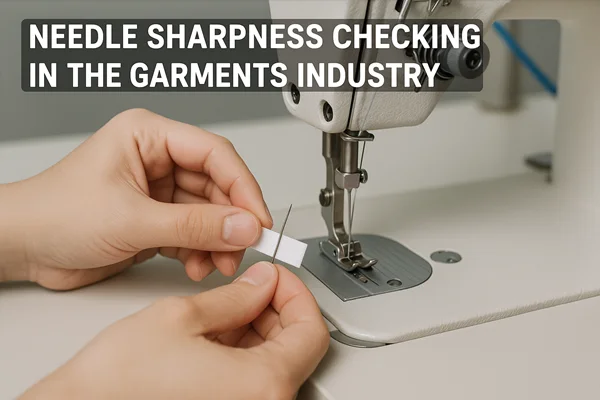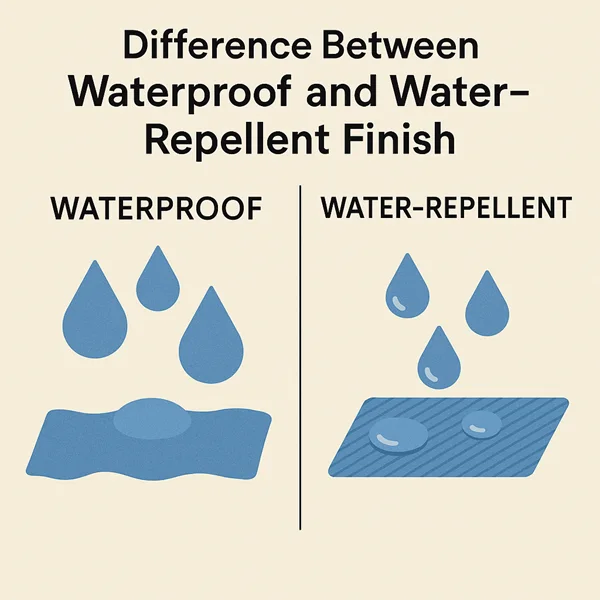Needle Sharpness Checking in Garments Industry
To establish a standard procedure for checking and ensuring that the needle point is free from defects and damage, reducing the risk of fabric damage, and ensuring product quality during the sewing process at FG. This procedure applies to all sewing machines and operators involved in production at FG, ensuring that needle points are inspected and approved before use in sewing operations. This content is all about Needle Sharpness Checking in the Garments Industry.

Teams’ Responsibilities to check Needle Sharpness
Who needs to do what for Needle Sharpness Checking in Garments:
- Product Safety Officer: Oversee and ensure compliance with needle sharpness checking procedures across all sewing lines. Maintain and review Needle Sharpness Inspection Logs and ensure proper documentation. Ensure that all operators and supervisors are trained on needle sharpness checks and machine handling. Target: Zero incidents of fabric defects caused by needle sharpness issues. Ensure 100% of needle checks are logged and verified each shift.
- Sewing Machine Operator: Perform needle sharpness checks as per the established schedule (before the shift, after the lunch break, and at the final inspection). Report any needle defects or wear to the line supervisor immediately. Replace needles as necessary, following proper procedures. Target: Ensure 100% compliance with the needle checking schedule. Avoid production delays due to needle defects.
- Line Supervisor: Monitor and ensure that all operators conduct needle sharpness checks on time. Verify the accuracy of needle sharpness logs and submit them to the Product Safety Officer. Ensure proper alignment of needles and timely replacement when defects are identified. Target: Zero production stoppages due to needle-related issues. 100% adherence to needle replacement and logging procedures.
- Maintenance Technician: Assist with needle replacements when operators report any issues. Conduct routine maintenance checks on sewing machines to prevent needle misalignment. Ensure needle alignment is correct to avoid fabric damage and defective sewing. Target: 100% machine readiness with properly aligned needles. Zero instances of machine-caused sewing defects.
- IE Executive: Track and analyze data from Needle Sharpness Inspection Logs for potential efficiency improvements. Work with line supervisors and maintenance teams to optimize needle replacement schedules and reduce machine downtime. Implement training and process improvements to enhance needle checking procedures and reduce defects. Target: Optimize production efficiency by reducing needle-related defects and downtime by at least 10%. Ensure a smooth needle checking process with minimal interruptions to production.
Procedure of Needle Sharpness Checking
- Ensure that the thread is removed from the needle before testing.
- Use a thin knitted nylon fabric or taffeta as the testing material.
- Ensure that the fabric surface is tight under the pressure foot.
- Set up the sewing machine without thread.
- Perform needle penetration by pressing down and up through the test fabric.
- Inspect the fabric for visible defects.
- A needle is considered blunt if any of the following signs are observed on the test fabric: Yarn breakage or pulling, Fraying, Visible holes or marks.
- A needle is considered sharp if there are no visible defects such as yarn pulling, breakage, or holes in the test fabric.
- Needle sharpness must be checked three times per shift: Before the start of the shift, after the lunch break, and during the final inspection before the shift ends.
- Additional checks should be performed if any needle damage or fabric defects are detected.
- Inspect the needle at the start of every shift or after every needle change.
- Hold the needle between two fingers and visually inspect for any irregularities such as: Bent tips, blunted or worn points, nicks or notches along the needle shaft.
- Ensure the needle is correctly aligned within the machine before starting operations.
- Incorrectly aligned needles can lead to sewing defects such as skipped stitches and fabric damage.
- Incorrectly aligned needles can lead to sewing defects such as skipped stitches and fabric damage.
- In the case of a blunt or broken needle, it must be replaced immediately following the Needle Replacement Procedure.
- The replacement of the needle must be recorded in the Needle Maintenance Log.
- Periodically inspect the needle during sewing operations, especially after every 2-3 hours or after a needle-related fabric defect is identified.
- Each check should be documented in the Needle Sharpness Inspection Log.
- The log must include the machine number, operator name, time of the check, and whether a needle replacement was required.
1.1.1 Routine Checks
- Periodically inspect the needle during sewing operations, especially after every 2-3 hours or after a needle-related fabric defect is identified.
- Check needles after sewing high-friction materials like denim, which can cause faster needle wear.
1.1.2 Record Keeping
- Each check should be documented in the Needle Sharpness Inspection Log.
- The log must include the machine number, operator name, time of the check, and whether a needle replacement was required.
- The supervisor must ensure that the logs are up-to-date and submitted to the product safety officer at the end of each shift.
1.1.3 Training
All operators, line supervisors, and quality controllers must undergo training on needle sharpness checking procedures and machine handling to minimize needle-related defects.
2. Safety & Precaution
- Operators must wear protective gloves during the needle check process to avoid injuries.
- Store needles in designated needle disposal boxes after removal to prevent workplace hazards.
3. Key Principles & Tools
- Inspection magnifying glass, needle disposal box, and replacement
Needle kit.
- Accuracy in needle inspections ensures defect-free sewing.
- A sharp and undamaged needle contributes to higher production efficiency and garment quality.
Needle sharpness refers to the condition of a sewing needle’s tip, ensuring it is fine, intact, and capable of smoothly penetrating fabric without causing damage. A sharp needle allows for efficient stitching, reduces the risk of issues like skipped stitches, fabric tearing, or yarn pulling, and ensures higher production quality.
Dull or blunt needles, on the other hand, can result in poor stitching, fabric defects, and production inefficiencies, making regular needle sharpness checks critical in garment manufacturing.
- You may love to read: Different Parts of the Sewing Machine Needle



